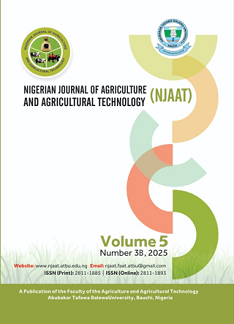OPTIMIZING SOWING DATE AND BOTANICALS APPLICATION FOR SUSTAINABLE MANAGEMENT OF FALL ARMYWORM [Spodoptera frugiperda (J.E Smith)] AND ENHANCED MAIZE PRODUCTIVITY IN THE SUDAN SAVANNA OF NIGERIA
Keywords:
Botanicals, FAW, Insecticides, Sowing window, Maize, ProductivityAbstract
A field experiment was conducted during the 2024 rainy season at Bayero University Kano (BUK) and Minjibir, Nigeria, to assess the effects of sowing window and botanical applications on fall army worm (FAW) infestation and maize performance. Three sowing windows; early (6-8 July), intermediate (16-18 July), and late (26-28 July) as main plot, were tested in combination with eight botanical treatments, three botanical mixtures, a synthetic insecticide (Deltamethrin 25% EC), and an untreated check as sub plot in a split-plot design with three replications. The results revealed that, early sowing significantly (P < 0.001) reduced larval populations, leaf damage, and egg mass counts compared to late sowings, with late sowing recording the highest pest pressure. Deltamethrin was the most effective treatment across locations, followed closely by neem seeds, garlic cloves, neem leaves, and chili pepper fruits, which achieved notable reductions in FAW incidence and damage (larval counts reduced by up to 52% compared to control). Yields were highest in early-sown plots treated with either Deltamethrin or neem-based botanicals. No significant (P > 0.05) sowing window × botanical interactions were detected, indicating independent effects. The results highlighted that early sowing between 6-8 July, combined with locally available botanicals particularly neem seeds and garlic cloves can effectively suppress FAW, reduce reliance on synthetic insecticides, and improve maize yields. Adoption of these integrated approaches offers a sustainable, affordable, and environmentally friendly strategy for FAW management in the Sudan Savanna.
Downloads
Downloads
Published
How to Cite
Issue
Section
License
Copyright (c) 2025 Nigerian Journal of Agriculture and Agricultural Technology

This work is licensed under a Creative Commons Attribution-NonCommercial-ShareAlike 4.0 International License.
This work is licensed under a CC Attribution-NonCommercial-ShareAlike 4.0



